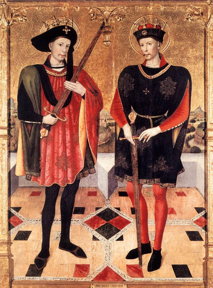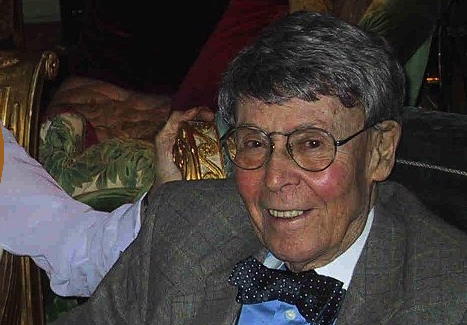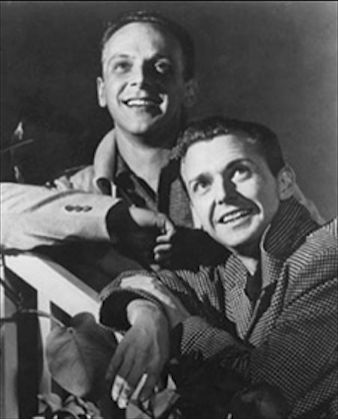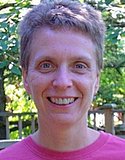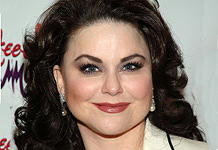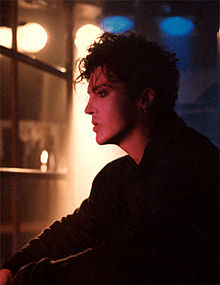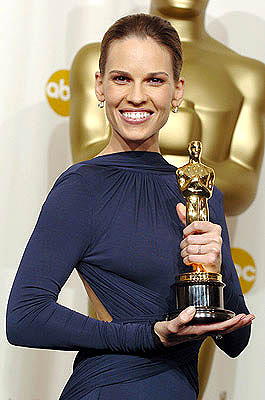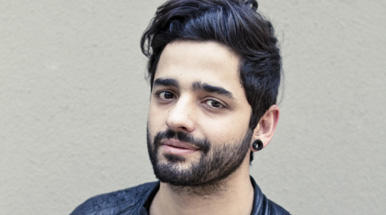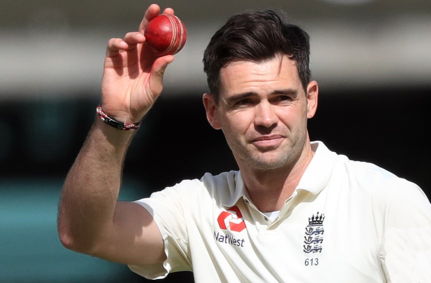|
presents THIS DAY IN GAY HISTORY based on: The White Crane Institute's 'Gay Wisdom', Gay Birthdays, Gay For Today, Famous GLBT, glbt-Gay Encylopedia, Today in Gay History, Wikipedia, and more …
Collected by Ted July 30 [{(o)}]|[{(o)}]|[{(o)}]|[{(o)}]| [{(o)}]|[{(o)}]
circa 250 – Saints Abdon and Sennen, variously written in early calendars and martyrologies Abdo, Abdus, and Sennes, Sennis, Zennen are recognized by the Roman Catholic Church as saints, with a feast day on July 30th. In some places they have been honored on March 21st and the first Sunday of May. Nothing is known historically about these saints except their names, that they were martyrs and that they were buried on July 30th in the Cemetery of Pontianus on the Via Portuensis. Because of this lack of knowledge about them, they are no longer included in the Roman Catholic calender of saints to be commemorated liturgically worldwide. Their Acts, written for the most part prior to the 9th century, describe them as Persians, martyred under Decius, in about the year 250, and contain several fictitious statements about the cause and occasion of their coming to Rome and the nature of their torments. A fresco found on the sarcophagus supposed to contain their remains represents them receiving crowns from Christ in a possible representation of the adelphopoiia (marriage) ceremony. [see Gay Wisdom below]
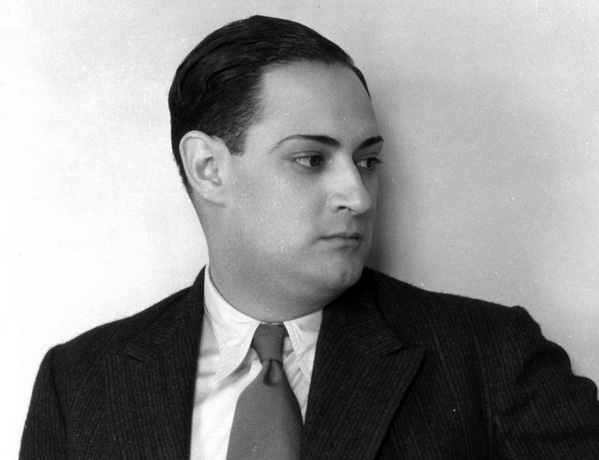
1904 – Salvador Novo (d.1974) was a Mexican writer, poet, playwright, translator, television presenter, entrepreneur, and the official chronicler of Mexico City, his birthplace and home. As a noted intellectual, he influenced popular perceptions of politics, media, the arts, and Mexican society in general. Novo defied the machismo and conservative Catholicism prevalent in 20th century Mexican culture by making almost no efforts to conceal his homosexuality. He was, however, accepted by the Mexican government. He held official posts related to culture, was elected to the Mexican Language Academy, and had a television program on Mexico City's history. Towards the end of his life, he dyed his hair a bright carrot color and wore many ostentatious rings and colored suits. He has been compared to Oscar Wilde, but unlike Wilde, Novo never suffered the setback of scandal or persecution and remained an accepted and respected member of society and governmental circles until his death. In fact, some sectors resented the fact that a gay writer would align himself so closely with the government and media after the repression of social movements in the 1960s and 1970s. He was well known for his wit. When a party, where young soldiers had been invited by homosexual intellectual friends of his, had degenerated into a fight and a scandal, Salvador Novo brushed off the whole matter with a factual: "This is what happens when members of the intellectual elite try to enter military circles." In accordance with tradition, the street on which he lived was renamed after him when he assumed the role of Mexico City's official chronicler, a post held for life.
1910 – Edgar Domingo Evia y Joutard, known professionally as Edgar de Evia (d.2003), was a Mexican-born American photographer. De Evia was born in Mérida, Yucatán, Mexico. His mother was a French-born concert pianist and his father was a wealthy landowner who was a member of two families that have been prominent in the politics and culture of Yucatán since the mid-19th century. On 30 June 1912, at the age of two, Evia arrived with his family in New York City aboard the liner Progreso. He graduated from The Dalton School in 1931. Edgar served as the research assistant to Dr. Guy Beckley Stearns, a homeopathic physician with whom he wrote and published articles and one book about homeopathy. The doctor gave Edgar his first camera and taught him to use it. He is best known for his Tissot-like effects using soft focus and diffusion. His career was long - from the 1940s through to the 1990s -and took in a full range of commercial and fashion photography for various newspapers, magazines and advertising campaigns for corporate clients. For almost two decades his home and studios were on the top three floors of 867 Madison Avenue in the Rhinelander Mansion, which he shared with his partner Robert Denning. and which is now Ralph Lauren's Madison Avenue flagship store. Later in his career he founded and was the creative director for a company that took all of the photographs for a number of department store catalogues. During the last decade of his life he wrote several novels and many short stories. He also applied his artistry to digital artwork on his Power Mac. The only common denominator was that none of his drawings looked like computer art. He died in 2003, just short of his 93rd birthday when pneumonia set in after a fractured hip. In the 1950s, de Evia's companion and business partner was Robert Denning, who worked in his studio and who would become a leading American interior designer and partner in the firm Denning & Fourcade. From 1966 until de Evia's death, his companion and business partner was David McJonathan-Swarm.
1915 – Brooklyn-born, George Forrest Chichester Jr , known professionally as Chet Forrest (d.2005), was a writer of musical theatre. Throughout his career, he worked exclusively with his musical and life partner Robert Wright. Most of their famous works were classical music adapted for the musical stage. They are best known for the musical Kismet (1953) based on the music of Alexander Borodin, which won the 1954 Tony for Best Musical and Song of Norway (1944) based on the work of Grieg. Prior to their career in musical theatre, the pair were contract songwriters at MGM and were Oscar-nominated three times for their songs; when their contract ended in 1942, they turned to the stage. 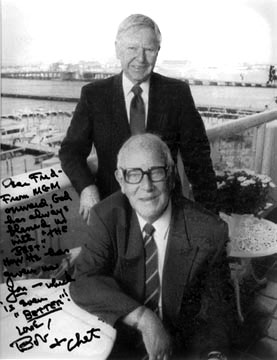 Wright & Forrest in 1993 Forrest's death in 1999 brought to an end a loving and creative partnership of over seven decades. Wright and Forrest's professional career included work in film, television, radio, the cabaret circuit, and most notably the stage, rightfully acknowledged when they were given the 1995 ASCAP/Richard Rodgers Award for their contributions to American musical theatre. Robert Wright died in 2005.
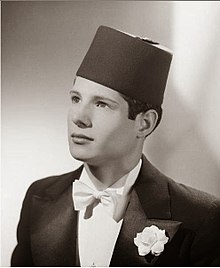
1920 – Salim Halali (d.2005) was an Algerian singer who performed Algerian music and Arabic Andalusian classical music. He was a pop singer rather than a professional performer of traditional Arab-Andalusian music, in which he had no formal training. Many of his songs remain popular in North Africa and among Jewish and Muslim North African communities in France, where he is "an iconic figure of French-Arab cabaret music." Salim Halali was born in Bône (Annaba), Algeria, in a family originally from Souk Ahras. His father was of Turkish origin and his mother was of Judeo-Berber origin. Halali stowed away on a ship bound for Marseille in 1934[5] and reached Paris in 1937 where he became successful as a singer in Parisian flamenco clubs, and met the Algierian music hall artist Mohamed el Kamel, who wrote Halali's first songs. In later years, Mohand Iguerbouchène composed fifty songs for him. In 1938, Halali toured Europe and his flamenco records in Arabic became successful in North Africa. During the German occupation of France, Si Kaddour Benghabrit, the founder and first rector of the Great Mosque of Paris, managed to hide Halali's Jewish roots by providing him with a false birth certificate as a Muslim and etching the name of his late father on a tombstone at an unmarked grave in a Muslim cemetery Bobigny (Seine-Saint-Denis). Halali used to perform at the mosque's Moorish café alongside such artists as Ali Sriti and Ibrahim Salah. After the war, he renewed his successful performing career. In 1949, he moved to Morocco, bought an old café in Maârif, the cosmopolitan quarter of Casablanca, and transformed it into a prestigious cabaret, Le Coq d'Or. He lived in Cannes in the early 1960s. In the late 1960s, he recorded a version of "My Yiddishe Momme", a 1925 American vaudeville hit, in Arabic. He expressed affection for the Muslim youth of the Parisian banlieues. When he performed in Jerusalem in the 1960s and said in Arabic from the stage "Long live the Arab nation", the audience threw things at him. He left the stage and never visited Israel again. He made no secret of the fact that he was gay and lived openly with his partner Pierre as early as 1949. Tom Cohen, the head conductor and artistic director of the Mediterranean Orchestra of Ashkelon, summed up Halali's life and influence thus:
The man was an enigma. A homosexual surrounded by women, an outright anti-Zionist who came to appear in Israel. Musically he was diverse as well, and was blessed with lots of color and richness. On the one hand, his singing was essentially Arab. On the other hand, he corresponds with styles that also spoke to Western ears. At heart he was a pop singer, the sort who performed in coffee shops and at weddings.
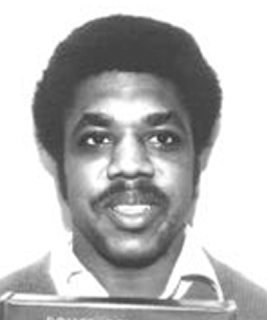
1953 – Tony Adams (d.1978) was a gay African-American socialist. Born in Baltimore, Maryland, Adams was raised in Salt Lake City and graduated from Judge Memorial High School. He was murdered on Nov. 3, 1978. He was attending the University of Utah at the time of his death. Rev. Bob Waldrop, then pastor of the Salt Lake Metropolitan Community Church, called him "a true freedom fighter." Activist Tony Adams As a leader in the Salt Lake Chapter of the Socialist Workers Party, Adams had helped organized the Anita Bryant Protest in 1977. His membership in the SWP kept the leadership of Dignity/Integrity, Catholic and Episcopalian gay support groups, from joining the Salt Lake Coalition for Human Rights of which he was a member. They claimed that their Christian values made them not want to associate with a Marxist. At the time of his murder, Tony Adams was the campaign manager for the Socialist Workers Party Congressional candidate Bill Hoyle who ran in the Nov. 7 general election. Adams was murdered just days before this election, which led the National Socialist Workers Party to believe that Tony's death was politically motivated. At about 8:45 p.m. on Nov. 6, 1978, Bill Woodbury, Adams' boyfriend, Rev. Bob Waldrop, and another friend went to Adams' apartment at 125 E 1st Avenue. They were concerned because no one had seen or heard from him for several days. After climbing in through a window, Woodbury found his boyfriend in the bedroom, naked and covered with blood. Adams had been stabbed repeatedly with a butcher knife and his throat slit. An autopsy showed that he had been dead for several days and murdered on Nov. 3. During that November, gay leaders patiently waited for the police to catch Tony Adams' killer(s). When news of the assassination of Harvey Milk on Nov. 27, 1978 reached Salt Lake City, gay activists in Utah feared the worst — that vocal gays were being targeted. Rev. Waldrop told the city officials that he himself had been the recipient of 22 death threats in the past two years, and added he had heard rumors that police were looking the other way when violent acts against homosexuals happened. Community leaders were not satisfied with the officials' responses and claimed that they had inside knowledge from a "closeted police officer" that some officers in the police department joked about Adams' death, saying, "Nigger, Queer, Communist — Three Strikes You're Out." Waldrop noted that four persons with ties to the gay community had recently been murdered in the Salt Lake area. For whatever reason Tony Adams was murdered his death sent a pall over the newly emerging gay community, imparting to many activists a sense of melancholy and fear. Gay Liberation activism virtually came to an end in Salt Lake City for the next four years until a new generation of gay leaders unfamiliar with the events of 1978 came forward to take their place.Tony Adams' murder remains unsolved to this day and is listed as cold case #1978-86442. The police's synopsis of the crime is simple: "The victim was found inside his apartment. He had been stabbed. The initial investigation showed that the victim was a member of a local radical element."
1954 – Writer Paula Martinac's career has been devoted to exploring and documenting the place that lesbians occupy in society, history, and the family. Whether in her fiction, her syndicated column, or in a unique guidebook to gay historical sites, Martinac is always most interested in the ways in which lesbians affect and are affected by the society around them. In 1982, she left West Virginia and moved to New Jersey to work as a production editor at the publishing firm Prentice Hall. That same year she joined the editorial collective for the New York City feminist newspaper, WomaNews. From then on, New York would be Martinac's city and the setting for many of her novels and short stories. Martinac's work at WomaNews was the start of a long and productive involvement in women's publishing. In 1985, she went to work as production director at the Feminist Press at City University of New York. She worked on production at the Press until 1994 and after that continued to contribute as a freelance writer. In 1988, Martinac joined the editorial board of the feminist literary magazine Conditions, which was published in Brooklyn. From 1990 to 1995, she co-chaired the board of directors of New York's Lesbian and Gay Community Services Center, where she established a lesbian and gay reading and writing series titled "In Our Own Write." In 1989 she published Voyages Out One: Lesbian Short Fiction, an anthology of stories written by Martinac and Carla Tomaso, another lesbian writer. That year she also edited another short story anthology, The One You Call Sister: New Women's Fiction, in which different writers, lesbian and straight, explore the unique connection between sisters. In 1990, Martinac published her first novel, Out of Time, a fantasy romance that playfully explores the history of lesbian identity. Out of Time tells the story of a modern lesbian who is first mesmerized, then bewitched, by a photograph of lesbians from the 1920s that she finds in a scrapbook in an antique shop. Martinac has continued to publish prolifically. Her works not only include novels—such as Home Movies (1993), about a family's complex reaction to loss filtered through the memory of a lesbian novelist, and Chicken (1997), a comic novel about a forty-something ghost writer who embarks on affairs with two twenty-somethings after she is dumped by her lover—but also a variety of other books as well. In k.d. lang (1996), a young adult biography of the lesbian chanteuse, she paints a compelling portrait for young readers of growing up lesbian. In The Lesbian and Gay Book of Love and Marriage: Creating the Stories of Our Lives (1998), Martinac draws from her own experiences in a long-term committed relationship with her life-partner Katie Hogan, a writer and teacher, to explore the new frontier of gay marriage. Until recently, Martinac shared her humor, insight, and politics with readers in an immediate and regular way in her column "Lesbian Notions," which is syndicated in queer news journals throughout the country. The column was originated by Martinac in 1997; it is now written by veteran activist Libby Post.
Burke is best known for role as Suzanne Sugarbaker in the CBS comedy series Designing Women (1986-1991), for which she was nominated for two Emmy Awards for Outstanding Lead Actress in a Comedy Series. In subsequent years she returned to television with a string of short-lived sitcoms, such as Delta (1992-1993), Women of the House (1995) and DAG (2000-2001).[1] She has also produced and played roles in made-for-TV movies, appeared in movies, like What Women Want, performed on Broadway productions and guest starred on television series, including Saturday Night Live, Boston Legal and many more. Burke is a supporter of gay rights, and has worked with openly gay playwright and screenwriter Del Shores on many occasions, in Sordid Lives and Southern Baptist Sissies. In 2006, Burke and openly gay Tennessean actor Leslie Jordan were disinvited from the Nashville talk show Talk of the Town after the show's managing director decided the subject matter to be discussed would offend the conservative viewers. Burke first became supportive of gay people and gay rights through attending acting school in London and also through her sister, Jennifer, who is a lesbian.
1960 – The French National Assembly adds homosexuality to a list of “fleaux sociaux” (social plagues) that the government is charged to combat.
A graphic artist turned performance artist, Norman Bedard emerged from the Montreal underground music scene in the early '80s under the name Norman Iceberg. One of a handful of gender-bending new wave artists to come out following the success of artists like Duran Duran, Boy George and Gary Numan, Bedard was recruited by music producer Tony Green, responsible for France Joli’s 1979 disco hit "Come To Me". Norman Bedard's experimental, minimal electro sound was therefore remodeled to cater to the dance club scene as evident on his debut, Be My Human Tonight. Person(a), released in 1987, was a conceptual collection of synthpop songs reflecting a young man’s own vision of life, and featuring keyboardists such as Lenny Pinkas (Men Without Hats), Mario Spezza (Rational Youth) and Mic Lussier. The cover photograph of him posing nude – pre-dating Prince’s Lovesexy by several months - stirred up controversy. A few selections taken from Person(a) were used for TVA’s Le Match de la Vie hosted by Quebec author and former politician Claude Charron. In the early '90s, American music industry executives strongly advised him to change his name in order to avoid any confusion with new rap artists Ice-T, Ice Cube and Vanilla Ice. However, with a strong gay following, Bedard decided to keep using his stage name, performing notably at the 1992 Los Angeles Gay Pride, the notorious Whisky A Go-Go, as well as Prince’s Glam Slam, backed by dancers Viktor Manoel (from David Bowie’s 'Glass Spider' tour), Luca Tommassini and Carrie Ann Inaba (from Madonna’s 'Girlie Show' tour). He also performed acoustic sets with American actor Robert Consoli on guitar. Ending a series of concerts with a five-piece rock band at The Roxy Theatre in Los Angeles, Bedard’s actual last appearance under the name Norman Iceberg was on the syndicated TV show Sheena Metal's Freakin' Rock Review in 1993. He also recorded as Norman Joseph in 1994 before deciding to go back to using Norman Bedard, his last birth name.
Prior to being elected to Congress he worked as an executive in a private equity firm and as an attorney. In 2006 he ran for the Democratic primary for New York Attorney General, but came in third to Mark J. Green and winner Andrew Cuomo. He was elected to the U.S. House of Representatives in 2012 after defeating Tea Party-backed Republican incumbent Nan Hayworth. He is the first openly gay person to be elected to Congress from New York. Maloney was born in Sherbrooke, Quebec; while both his parents are Americans his father's work as a lumberjack temporarily brought them to Canada. Maloney grew up in Hanover, New Hampshire with his six siblings in what he describes as a "small Irish Catholic family. Maloney has been with his partner Randy Florke since 1992, when they met in New York City where Maloney was helping plan the Democratic National Convention. Together they have three adoptive children: Jesus, Daley, Essie. Florke is an interior decorator who has been featured in Oprah's magazine. Maloney and his family live in the Putnam County community of Cold Spring, New York. In an interview, Maloney described his personal hero as Atticus Finch from Harper Lee's Pulitzer Prize-winning novel To Kill a Mockingbird. Maloney personalized him as "the greatest guy ever—a good dad, a good lawyer" and "who I want to be when I grow up."
Silveira is a transgender man. The Cliks made history as the first band with an overtly transgender male leader signed by a major record label, Tommy Boy Entertainment's gay-friendly imprint Silver Label. Born in Canada as Lilia Silveira to a musical Portuguese-Canadian family, he lived from the age of four to the age of ten on Pico Island, part of the Azorean archipelago (an autonomous region of Portugal). At age ten, Lucas' working-class, family moved back to the suburbs of Toronto and enthusiastically supported his fervor for music. He was about three when "I knew exactly who I was at that age, which sucked, not having words for it and being told I was something else." He knew he was a boy and asked his mother to buy him a penis like his brothers. His mother told him that was "ridiculous", but his yearning for a penis never went away. He suppressed his feelings about his identity and tried to make it go away. He spent years telling himself that he had mental problems and that he needed to get help. He didn't talk to anyone about it. He said, "Then when I was in my middle teens, the first time I heard about Transgender people, or even the word 'transgender' was on Geraldo Rivera. I remember seeing this guy with a beard, and they were like, 'This man was born a woman!' I was like, 'Holy shit! That's me.'" Then he heard about the murdered transman, Brandon Teena and was "completely and utterly horrified". At 17, he then decided to come out and live as a lesbian, as a safer alternative. After realizing he could not, in truth, live his life as a lesbian, he decided to take undergo transgender surgery to be his true self. Silveira chose not to take testosterone because of all the negative effects it could have on his singing voice. He has had "top surgery". A mistaken belief is that "all" top surgery encompasses is a double mastectomy, but in reality, it is a much more complicated surgery. Using part of the breast tissue that has been removed, a male chest is constructed that looks natural and is socially acceptable to go shirtless. He said it makes him feel "grounded." He said: "I had this kid came up to me and told me that he identified as transgender. He said to me, 'You're my hero. If it wasn't for you, I'd feel like a freak.' I'm not the poster boy for anything, but it sure makes me feel a certain type of validity, and happy at the choice I've made in my life to be out there and be who I am. Because it's obviously making a difference to a couple of people. So I'm very happy to talk about it. It's not a burden or anything like that. I am very happy."
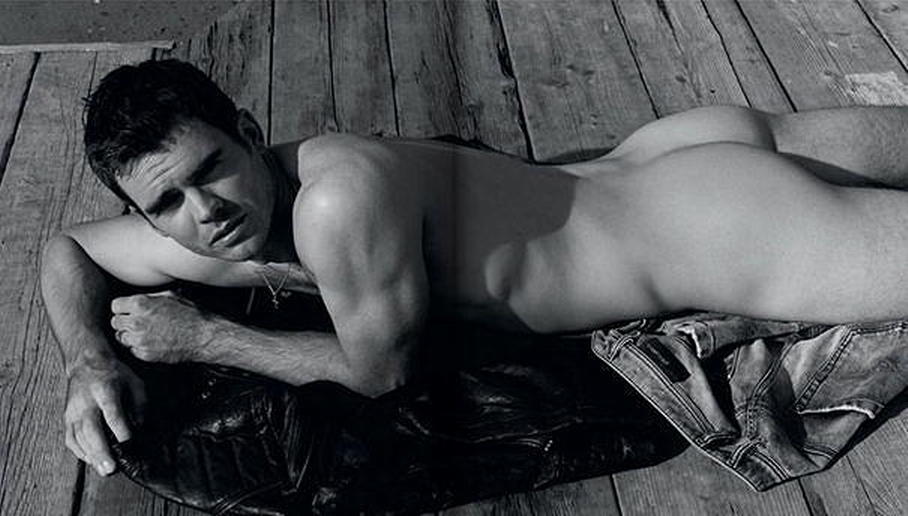 (Click for larger) Anderson became the first cricketer to model naked for Attitude, "Britain's biggest-selling gay magazine", in September 2010. He stated "If there are any gay cricketers they should feel confident enough to come out because I don't think there is any homophobia in cricket."
1998 – Dr. Joep M. A. Lange of the University of Amsterdam reported the successful results of a study using a five-drug combination regimen to combat AIDS.
[{(o)}]|[{(o)}]|[{(o)}]|[{(o)}]| [{(o)}]|[{(o)}] TODAY'S GAY WISDOM:We repeat this historic post every year to refute the
argument is being made that marriage has "always been between one man
and one woman." We have historian John Boswell to thank for the discovery of these passages. In 1994 John Boswell published a book—Same Sex Unions in Pre- Modern Europe (New York: Villard, 1994) which claimed, essentially, that the adelphopoiia rite known to have been used in Orthodox and Greek rite Catholic Churches constituted, in usage at least, a form of ecclesiastical blessing for homosexual unions. To say the least, this claim has been highly contested. Boswell was not able to show that any high church body gave approval to such a use of the rite, but was able to show, as most critics allow, that the rite was both fairly widespread [he had about 70 manuscripts], and that it probably was used by some same-sex couples to give some outward sign to their relationship. There are contrary indications about the entire ceremony. The late 18th century Orthodox law text known as the Pedalion or Rudder does indicate that the ceremony was [ab]used in this way. From a much earlier date, St. Theodore of Studium in his Reform Rules seems to relate the ceremony to marriage. On the other hand, the Life of St. Mary the Younger, which is quite willing to use strong marital imagery about male-male relationships, describes [ch. 2] the development of one such relationship, between Mary's brother and a drungarius (or military officer), in which the couple agree that the bonds of kinship need to be added to their bond of love - and so the drungarius marries Mary. [I should note that I had made this observation, in an unpublished paper, some time ago. Alice Mary Talbot of Dumbarton Oaks strongly doubted that interpretation, but it is supported in the forthcoming translation and commentary on the Life by Angeliki Laiou, also of Dumbarton Oaks.] Presented here is Boswell's translation of one of the various manuscripts he has: Office for Same-Sex Union [Akolouthia eis adelphopoiesin] i. The priest shall place the holy Gospel on the Gospel stand and they that are to be joined together place their right hands on it, holding lighted candles in their left hands. Then shall the priest cense them and say the following: ii. In peace we beseech Thee, O Lord. Have mercy on us, O God. iii. The priest shall say: iv. Another Prayer for Same-Sex Union: v. Then shall they kiss the holy Gospel and the priest and one another, and conclude.
[{(o)}]|[{(o)}]|[{(o)}]|[{(o)}]| [{(o)}]|[{(o)}] |
